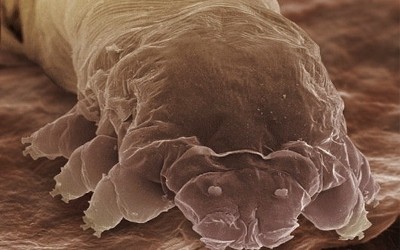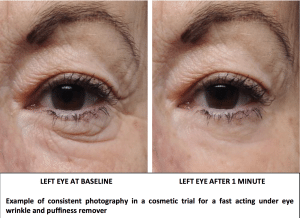Demodex is a genus of tiny parasitic mites that live in or near hair follicles of mammals. Around 65 species of demodex are known. Two species living on humans have been identified: demodex folliculorum and demodex brevis. d. folliculorum is found in hair follicles, while d. brevis lives in sebaceous glands connected to hair follicles. Both species are primarily found in the face, near the nose, the eyelashes and eyebrows, but also occur elsewhere on the body.
Skin concerns possibly caused by demodex mites
In the vast majority of cases, the mites go unobserved, without any adverse symptoms, but in certain cases (usually related to a suppressed immune system, caused by stress or illness) mite populations can dramatically increase, resulting in a condition known as demodicosis or demodex mite bite, characterised by itching, inflammation and other skin disorders. Blepharitis (inflammation of the eyelids) can also be caused by demodex mites. Evidence of a correlation between demodex infection and acne vulgaris exists, suggesting it may play a role in promoting acne.
Demodex mites have also been associated with other skin conditions such as rosacea. Rosacea is a chronic inflammatory disease of skin in young to middle aged adults, but can occur occasionally in children. At present, the etiology of Rosacea is not completely understood. Among other factors a causative role has been postulated for the hair follicle mites demodex folliculorum and demodex brevis. Demodex mites are commonly observed in subjects with rosacea.
Research conducted on demodex mites
In a recent study we conducted in Sydney, we adopted a technique called ‘skin surface biopsy’ (SSB) or ‘superficial skin surface biopsy’ (SSSB) to detect and quantify the demodex mites present in a skin sample. SSB is a technique that involves the collection of a sample of skin surface and analysis under the microscope at different magnifications. Testing takes just a few minutes and results are available in a few hours. This procedure allowed us to see the demodex mites in their natural environment (the skin) and still alive.
The aim of the study was to assess the efficacy of a topical product designed to stop proliferation of the demodex mites and improve some of the symptoms of rosacea associated with the mites (e.g. redness, itchiness). Therefore, once SSB had confirmed the presence of demodex mites on the skin of trial participants (one of the inclusion criteria for the trial), assessments were reaped after one and two months of treatment with the test product. This was a challenging but also very fascinating trial. We soon realised that if on one hand there is very little knowledge about the mites (even dermatologists are not always familiar with this issue), on the other end there is a lot of interest from the general public.
New market for cosmetic and pharmaceutical industries?
Although there are only a few products, mostly sold on line, that claim to be effective against the mites, some of the issues associated with demodex mites are slowly gaining momentum on the internet as more people talk about their skin and their symptoms. Not many people know about this mite who lives on our skin. But once they learn more about it through the internet, some rosacea or acne patients are relieved, to an extent, to know that some of their symptoms (for example intense skin redness and itchiness) maybe associated with demodex proliferation.
Further research is warranted to establish the effect of certain products on demodex mites associated with some common skin concerns. At the same time, product formulators are presented with the opportunity to work on new preparations designed for people affected by demodex mites. The effectiveness of such products can either be addressed from a cosmetic point of view (product designed to improve the appearance of skin) or therapeutic (remedy to treat demodex mites). Anyone up for a challenge?




